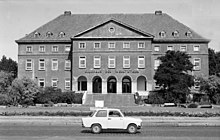Culture house




In many places and cities in Germany and Austria, Kulturhaus is used to denote cultural centers that are dedicated to a variety of cultural activities (exhibitions, theater, cabaret and music evenings, lecture series). They are mostly under municipal sponsorship and are publicly funded. The term was mainly used in the GDR, while in the Federal Republic the terms village community center , community center or community center were used for similar functional buildings . The forerunners of the Kulturhaus in Germany were the Volkshaus (people's houses) that were built in the labor movement at the end of the 19th century .
Houses of culture in socialist states
In socialist countries, the culture house was a facility for cultural purposes in which exhibitions, meetings, lectures, concerts, discos, music lessons, receptions took place and in which cultural or sporting “circles” and groups (drawing circles, writing circles, etc.) could be active.
In almost every town and in many villages, the state or large local companies built and financed a cultural center or made the premises available free of charge. In addition to the theaters, cinemas, churches, pioneer houses and sports facilities, they were an important part of everyday culture in all socialist countries and, especially in smaller towns and villages, mostly the center of town and village life. The first cultural center in the Soviet occupation zone was the “Maxim Gorki” cultural center , which opened in Radeberg , Saxony in 1948 . In the GDR , the approximately 2,000 cultural centers often bore an epithet in honor of a socialist role model (e.g. “Kulturhaus Clara Zetkin ”, “ Ernst Thälmann ”, “ Maxim Gorki ”). The size and architecture of the cultural centers vary from rather inconspicuous multi-purpose halls to large representative buildings with column portico, elaborate foyers and large theaters. The Maxhütte cultural center in the small Thuringian community of Unterwellenborn, for example, includes a theater hall with 800 seats (as many as in the theater built in 2003 in the state capital Erfurt), a "music salon" with 200 seats, a dance rehearsal room, lecture rooms, a library, and several conference rooms and two restaurants.
In the GDR, cultural houses were created in all the architectural styles propagated in each case, from socialist classicism of the 1950s to the international modernism of the late GDR buildings. In the early years of the GDR, rural cultural centers were often still influenced by the Heimat style of the 1930s. There are only a few examples of classical modernism in the 1950s, such as the Bauhaus-style cultural center in Trebus from 1951 (today the “Seeblick restaurant”).
Even in today's socialist states such as the People's Republic of China , Cuba , North Korea and some post-Soviet countries such as Belarus , houses with this aim are called cultural houses.
Houses of culture in the new federal states
In the formerly socialist states, the name Kulturhaus was largely retained for existing buildings, as was the case in many places in the former GDR. Due to the funding cut by the federal government after 1990, many cultural centers in the new federal states were closed. They were sold, converted into a restaurant, discotheque or furniture store, or fell into disrepair. One example is the “Karl Marx” cultural center in Johanngeorgenstadt, which was built in 1956, the roof of which was extensively renewed after 1990 from public funds, but which was then closed and demolished in 2010.
Culture houses that have made the leap to accepted art venues or leisure centers or have been used for other purposes are the Kulturhaus Ludwigsfelde , the House of Culture and Education in Neubrandenburg, the Haus Schwärzetal in Eberswalde, and the cCe Kulturhaus Leuna, built in 1928 .
See also
- Kulturhaus der Stadt Braunau am Inn Kultur im Gugg
- Volkshaus , Volksheim , Feierabendhaus , community center , trade union center , society center , clubhouse , culture palace , palace of the republic , Tschitalischte
- List of cultural centers in the GDR
literature
- Joachim Otto Habeck: The culture house in Russia. Post-socialist cultural work between ideal and neglect . Transcript Verlag, Bielefeld 2014 ISBN 978-3-8376-2712-1
- Simone Hain, Stephan Stroux, Michael Schroedter: The salons of the socialists. Culture houses in the GDR . Ch. Links, Berlin 1996 ISBN 3-86153-118-6 (with many photos of the state of the cultural centers 1993–1996)
- Ulrich Hartung: Workers 'and farmers' temples. GDR cultural centers of the fifties. A compendium of architectural history. At the same time dissertation from the Humboldt University Berlin, 1996. Schlezky & Jeep, Berlin 1997 ISBN 3-89541-102-7 (history of the GDR cultural centers of the 1950s and detailed, illustrated catalog)
- Thomas Ruben, Bernd Wagner (ed.): Culture houses in Brandenburg. An inventory. Final report of the research project "The culture houses in Brandenburg, inventory and concept development" by the Kulturpolitische Gesellschaft e. V. Brandenburger texts on art and culture, volume 1. Verlag für Berlin-Brandenburg, Potsdam 1994 ISBN 3-930850-05-2
Web links
- Horst Groschopp : Culture houses in the GDR - forerunners, concepts, use . ( Digitized version )
- What happened to the culture houses of the GDR? , mdr.de
- Simone Hain / Stephan Stroux : The salons of the socialists . ( [1] )

